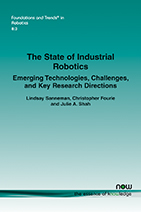The State of Industrial Robotics: Emerging Technologies, Challenges, and Key Research Directions
By Lindsay Sanneman, CSAIL, MIT, USA, lindsays@csail.mit.edu | Christopher Fourie, CSAIL, MIT, USA, ckfourie@csail.mit.edu | Julie A. Shah, CSAIL, MIT, USA, julie_a_shah@csail.mit.edu
Abstract
Robotics and related technologies are central to the ongoing digitization and advancement of manufacturing. In recent years, a variety of strategic initiatives around the world including “Industry 4.0”, introduced in Germany in 2011 have aimed to improve and connect manufacturing technologies in order to optimize production processes. In this work, we study the changing technological landscape of robotics and “Internet-of-Things” (IoT)-based connective technologies over the last 7–10 years in the wake of Industry 4.0. We interviewed key players within the European robotics ecosystem, including robotics manufacturers and integrators, original equipment manufacturers (OEMs), and applied industrial research institutions and synthesize our findings in this monograph. We first detail the state-of-the-art robotics and IoT technologies we observed and that the companies discussed during our interviews. We then describe the processes the companies follow when deciding whether and how to integrate new technologies, the challenges they face when integrating these technologies, and some immediate future technological avenues they are exploring in robotics and IoT. Finally, based on our findings, we highlight key research directions for the robotics community that can enable improved capabilities in the context of manufacturing.
The State of Industrial Robotics: Emerging Technologies, Challenges, and Key Research Directions
Robotics and related technologies are central to the ongoing digitization and advancement of manufacturing. In recent years, a variety of strategic initiatives around the world, including “Industry 4.0” introduced in Germany in 2011, have aimed to improve and connect manufacturing technologies in order to optimize production processes. In this monograph, the changing technological landscape of robotics and “internet-of-things” (IoT)-based connective technologies over the last 8-10 years, and in the wake of Industry 4.0, are studied. Key players within the European robotics ecosystem have been interviewed, including robotics manufacturers and integrators, original equipment manufacturers (OEMs), and applied industrial research institutions, and the findings are presented this monograph. State-of-the-art robotics and IoT technologies are detailed, and the processes companies follow when deciding whether and how to integrate new technologies, the challenges they face when integrating these technologies, and some immediate future technological avenues they are exploring in robotics and IoT are described. Finally, key research directions for the robotics community that can enable improved capabilities in the context of manufacturing are highlighted.
